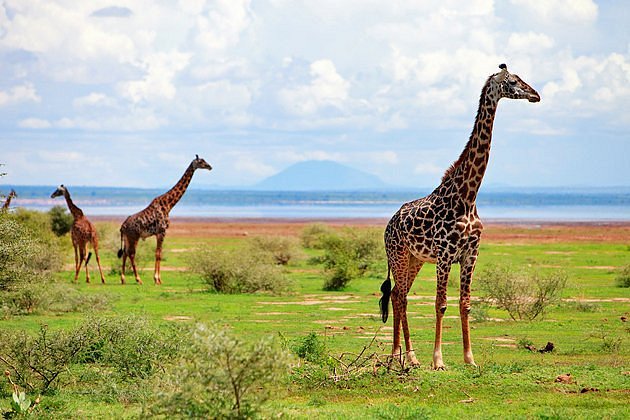Lake Manyara National Park, Tanzania
🌿 Lake Manyara National Park: Tanzania's Hidden Jewel of Biodiversity
Tucked between the dramatic cliffs of the Great Rift Valley and the sparkling shores of its namesake lake, Lake Manyara National Park offers a compact yet incredibly diverse safari experience. Although smaller than Tanzania's more famous parks like Serengeti or Ngorongoro, Manyara delivers unexpected beauty, remarkable wildlife encounters, and a tranquil ambiance that makes it a favorite among nature enthusiasts and photographers alike.
🦒 Wildlife Encounters: From Tree-Climbing Lions to Flamingo-Filled Shores
One of the park’s biggest claims to fame is its population of tree-climbing lions, a rare and fascinating behavior found only in a few places in Africa. These agile cats are often seen lounging on the branches of acacia trees, providing thrilling sightings for safari-goers.
🐘 Elephant Haven
Lake Manyara is also celebrated for its large elephant herds, often spotted meandering gracefully through the forests and open plains. These elephants are known for their calm demeanor and are among the highlights of any visit.
🐦 Birdwatcher's Paradise
With over 400 recorded species, Lake Manyara is a haven for birdwatchers. Thousands of lesser flamingos and pelicans paint the lake’s surface pink and white, while kingfishers, hornbills, and cormorants animate the skies and treetops. Whether you're a seasoned birder or a curious traveler, the park’s birdlife is a sight to behold.
🐗 More Wildlife Highlights
Other residents include giraffes, zebras, hippos, buffalo, wildebeests, and playful baboons, the latter of which are found in one of the largest troops in Africa. You might even glimpse elusive leopards in the park’s more forested areas.
🌳 Diverse Ecosystems: A Landscape of Contrasts
Despite covering just 330 square kilometers, Lake Manyara National Park offers a surprising variety of landscapes, ranging from lush groundwater forests to savannas, hot springs, and alkaline lake beds.
🌲 The Groundwater Forest
Upon entering the park, travelers are immediately immersed in a cool, jungle-like forest filled with fig trees and mahogany. This shaded area is often bustling with blue monkeys, hornbills, and startled dik-diks darting across the path.
🏜️ Acacia Woodland and Open Plains
As the road opens up to savannas and grasslands, herds of grazing animals become more visible. This shift in terrain also improves chances of spotting predators like lions and hyenas in their natural hunting grounds.
🌋 Maji Moto Hot Springs
Located at the southern end of the park, the Maji Moto hot springs are natural geothermal pools where mineral-rich water bubbles to the surface. Though not safe for swimming, the springs add a unique geological dimension to the landscape.
🚐 Getting There: Easy Access on the Northern Safari Circuit
Lake Manyara is one of the most accessible parks in Tanzania, making it an ideal first or last stop on a northern safari itinerary.
📍 Location
-
About 125 kilometers (2 hours) west of Arusha,
-
Just a 45-minute drive from Ngorongoro Crater
-
Part of the "northern circuit" along with Serengeti and Tarangire
🛬 By Air
Daily flights from Arusha, Dar es Salaam, or Zanzibar can bring you to Lake Manyara Airstrip, which is just minutes away from the park entrance.
🏨 Where to Stay: Lodge Life or Forest Camps
Accommodation ranges from luxury lodges perched on escarpments to cozy eco-camps in the forest. Many offer exceptional views of the lake, and some include night game drives or guided nature walks.
🌟 Top Options Include:
-
Lake Manyara Tree Lodge (luxury, treehouse-style accommodations)
-
Escarpment Luxury Lodge (incredible Rift Valley views)
-
Manyara Wildlife Safari Camp (mid-range comfort and convenience)
-
Public campsites for budget travelers and adventurers
📆 Best Time to Visit: When Nature Puts on a Show
The dry season (June to October) is ideal for general game viewing, as animals tend to gather around water sources and vegetation is less dense. However, for birdwatching and flamingo viewing, the wet season (November to May) is the most rewarding.
🌦️ Seasonal Highlights:
-
June–October: Best wildlife visibility
-
November–April: Birdwatching paradise, lush scenery
-
January–February: Calving season for many animals
🌍 Why Visit Lake Manyara National Park?
Lake Manyara may not have the same fame as Serengeti or Ngorongoro, but what it lacks in size, it makes up for in diversity, scenic beauty, and accessibility. It’s a place where you can experience rich biodiversity within a manageable timeframe, and it's perfect for families, first-time safari travelers, and those looking to explore less crowded parks.
The park’s unique tree-climbing lions, large baboon populations, and abundant birdlife make it more than just a stopover—it’s a destination worth savoring. Whether you’re embarking on a day trip or spending the night under the stars, Lake Manyara is sure to leave a lasting impression.


